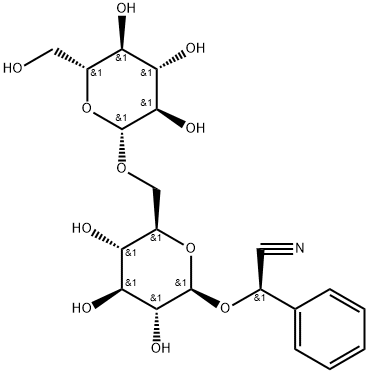Amygdalin , 97% , 29883-15-6
Synonym(s):
D -Mandelonitrile 6-O-β-D -glucosido-β-D -glucoside;D -Mandelonitrile-β-gentiobioside;Amygdaloside;Laetrile
CAS NO.:29883-15-6
Empirical Formula: C20H27NO11
Molecular Weight: 457.43
MDL number: MFCD00006598
EINECS: 249-925-3
| Pack Size | Price | Stock | Quantity |
| 1G | RMB47.20 | In Stock |
|
| 5G | RMB115.20 | In Stock |
|
| 25G | RMB400.00 | In Stock |
|
| others | Enquire |
PRODUCT Properties
| Melting point: | 223-226 °C |
| Boiling point: | 563.27°C (rough estimate) |
| alpha | -38.5 º (c=4, H2O) |
| Density | 1.4474 (rough estimate) |
| refractive index | -40 ° (C=2, H2O) |
| storage temp. | Sealed in dry,Room Temperature |
| solubility | H2O: 0.1 g/mL hot, clear to very faintly turbid, colorless |
| form | Powder |
| pka | 12.69±0.70(Predicted) |
| color | White to Off-white |
| optical activity | [α]20/D 39±2°, c = 2% in H2O |
| biological source | synthetic |
| Water Solubility | 83 g/L (25 ºC) |
| Merck | 14,597 |
| BRN | 66856 |
| Stability: | Hygroscopic |
| InChIKey | XUCIJNAGGSZNQT-SWRVSKMJSA-N |
| LogP | -2.237 (est) |
| CAS DataBase Reference | 29883-15-6(CAS DataBase Reference) |
Description and Uses
Amygdalin is a cyanogenic glycoside that has been found in seeds from plants of the Rosaceae family and has diverse biological activities. It induces cell cycle arrest at the G0/G1 phase, decreases cyclin A and Cdk2 levels, and inhibits cell growth in UMUC-3, RT112, and TCCSUP bladder cancer cells when used at concentrations ranging from 1.25 to 10 mg/ml. Amygdalin (3 mg/kg) reduces the number of primary microtubules and microvessels in aortic rings isolated from rats with diabetes induced by streptozotocin . In vivo, amygdalin reduces triglyceride, total cholesterol, and LDL levels and aortic sinus plaque area in an LDLR-/- mouse model of atherosclerosis. It also reduces production of TNF-α, IL-1β, and IL-6, as well as neutrophil and macrophage infiltration, in bronchoalveolar lavage fluid (BALF) in a mouse model of LPS-induced acute lung injury.
Amygdalin, a cyanide containing glycoside, may be used as a substrate to identify, differentiate and characterize enzymes such as maltase(s), emulsin(s) and β-glucosidase(s).
Safety
| Symbol(GHS) |  GHS07 |
| Signal word | Warning |
| Hazard statements | H302 |
| Precautionary statements | P264-P270-P301+P312-P501 |
| Hazard Codes | Xn |
| Risk Statements | 22 |
| Safety Statements | 26-36/37/39-45-24/25 |
| RIDADR | 2811 |
| WGK Germany | 3 |
| RTECS | OO8450000 |
| F | 10-21 |
| HazardClass | 6.1(b) |
| PackingGroup | III |
| HS Code | 29389090 |
| Hazardous Substances Data | 29883-15-6(Hazardous Substances Data) |
| Toxicity | LD50 orl-rat: 522 mg/kg WJMDA2 134,97,81 |




